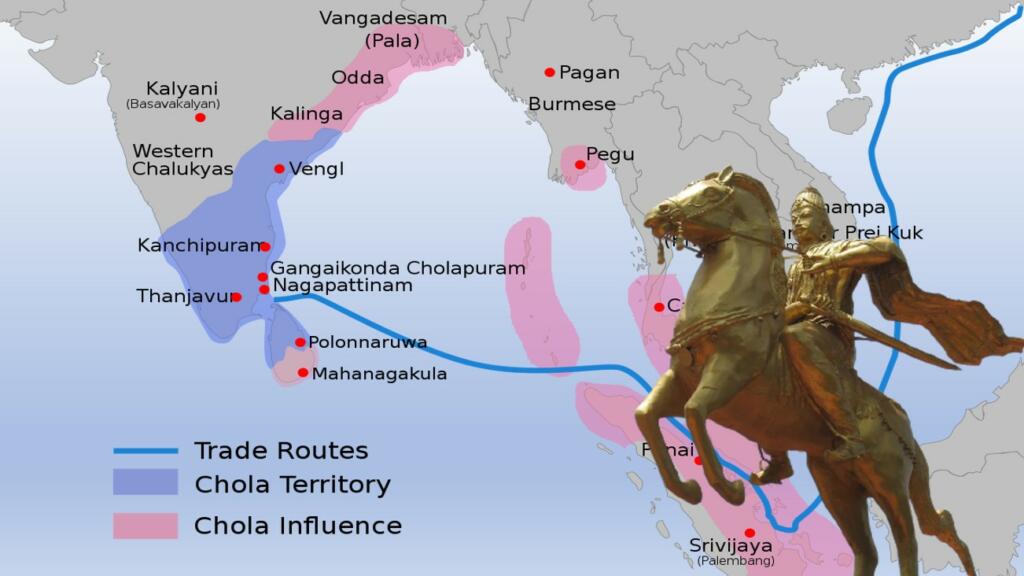The Chola Empire – reduced to a mere dynasty by India’s Marxist distorians, was the world’s longest-ruling kingdom. Calling Communists ‘historians’ would be a grave injustice to India’s past and the very study of history. How does one forget the fact that ever since India was freed from British rule, a concerted attempt has been made to undermine this civilisation’s grand ancient past? Nobody knows exactly when the first Chola kings took power in the southern point of India, but certainly, the Chola Dynasty was established by the third century BCE, because they are mentioned in one of emperor Ashoka’s stelae.
At its height, the Chola Empire controlled not only southern India and Sri Lanka but also the Maldives. It took key maritime trading posts from the Srivijaya Empire in what is now Indonesia, enabling a rich cultural transfusion in both directions, and sent diplomatic and trading missions to China’s Song Dynasty (960 – 1279 CE). The Chola Empire was based in the Kaveri River Valley, which runs southeast through Karnataka, Tamil Nadu, and the southern Deccan Plateau to the Bay of Bengal.
The Chola Empire was one of the greatest to have ever existed on the face of the earth. Under Rajaraja Chola I and his successors Rajendra Chola I, Rajadhiraja Chola, Virarajendra Chola, and Kulothunga Chola I, the dynasty became a military, economic and cultural power in South Asia and South-East Asia.
During the period 1010–1153, the Chola territories stretched from the islands of the Maldives in the south to as far north as the banks of the Godavari River in Andhra Pradesh. During the reign of Rajaraja Chola I and his successors Rajendra Chola I, Virarajendra Chola and Kulothunga Chola I, the Chola armies invaded Sri Lanka, the Maldives and parts of Southeast Asia like Malaysia, Indonesia and Southern Thailand of the Srivijaya Empire in the 11th century. In 1025, Rajendra Chola launched naval raids on ports of Srivijaya and against the Burmese kingdom of Pegu.
Read more: Hinduism in Malaysia
The invasions were short-lived. However, back then, they dramatically altered the geopolitics of Asia, especially on the trade and commerce frontier. The Chola dynasty had a robust military, of which the king was the supreme commander. It had four elements, comprising the cavalry, the elephant corps, several divisions of infantry and a navy. The Chola navy was the zenith of ancient Indian sea power. Without it, the conquest of the Ceylon islands and naval raids on Srivijaya would have been impossible.
Throughout the empire, Cholas operated hospitals. Foreign trade between India and other civilisations flourished. The period the empire existed was from 300 BCE to 1279 CE, with the empire reaching its zenith around 1030 CE. That is close to 1600 years of uninterrupted rule! One needs some time to completely imagine how an empire lasted this long. The duration is simply unprecedented. Yet, the question to be asked is this. Have Indian history textbooks done justice to this great empire?
The simple answer is no. For decades, Indian students have been taught mere snippets of the Chola Empire. The bulk of the focus has always been on studying the Egyptian, Mesopotamian, and European civilisations. But when it comes to the Cholas, they have been reduced to a few pages.
Marxist historians have a knack for discounting Hindu history, if not giving a complete miss to it in school and college textbooks. The indoctrination of students towards believing that Indian history begins and ends with Islamic rule over the country is started in schools itself. Forces that resisted Islamic rule, and which protected India, leading it to become the only civilisation which the Islamist marauders could not proselytise, are given insufficient credit, if at all. Meanwhile, they distort the facts to suit their own narrative, even in the minuscule portions that are reserved for such brave hearts.
The Cholas, Vijayanagar Empire, Ahoms and practically everyone who represented the best of India are given a complete miss by Marxist historians. In fact, this gang of historians also fabricates facts and evidence to solidify their own beliefs, which are taught to students across the country.
There is an immediate need for Indians to engage in self-study and learn more about empires that existed across India, and those like the Cholas – who braced entire millennia without fizzling out. The Cholas should be the first empire anyone chooses to study since their history is just so magnificent.
